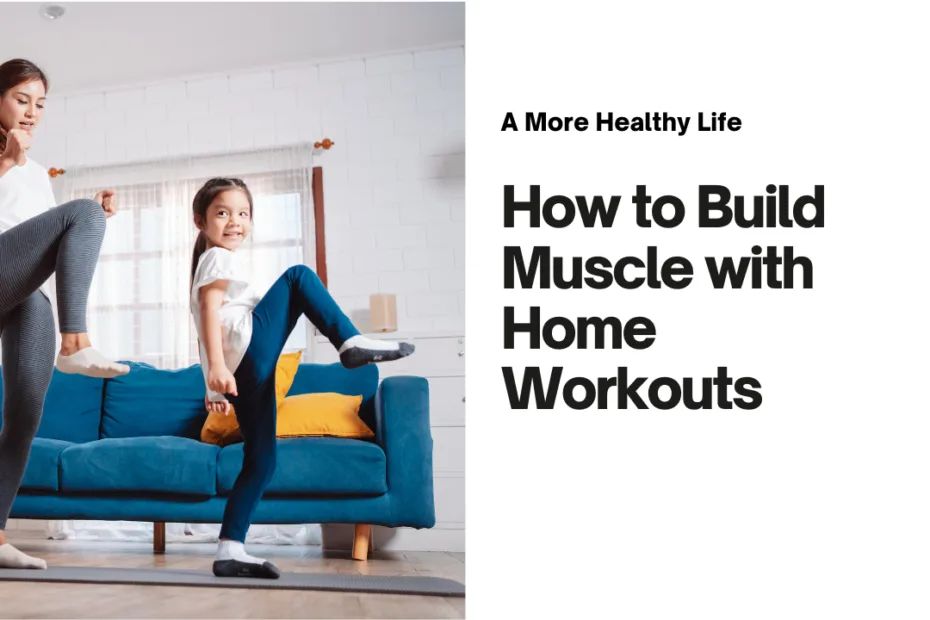How to Build Muscle with Home Workouts
Building muscle without access to a gym may seem like a challenge. Still, with the right approach, achieving impressive results from the comfort of your own home is possible. Whether short on time, looking to save money, or prefer exercising in your own space, home workouts offer flexibility and efficiency. Below is a guide on how to build muscle effectively using home workouts, covering essential principles, exercises, and tips for success.
The Basics of Muscle Growth
Before diving into exercises, it’s essential to understand the fundamentals of muscle growth or hypertrophy. Muscles grow when exposed to stress, leading to small tears in the muscle fibers. These tears are then repaired by the body, which makes the muscle stronger and larger over time. To achieve this at home, you need to focus on the following factors:
- Progressive Overload: This involves gradually increasing the resistance or intensity of your workouts to keep challenging your muscles. If available, you can achieve this by using bodyweight variations, resistance bands, or weights.
- Adequate Recovery: Muscle growth happens during recovery, not just during the workout. Ensure you eat a protein-rich diet and get sufficient sleep.
- Consistency: Like any fitness goal, building muscle requires consistent effort. Make a plan and stick to it. Regular workouts will yield the best results over time.
Practical Home Exercises for Muscle Building
Several highly effective exercises can help you build muscle at home. These exercises target major muscle groups and can be modified for different fitness levels.
- Push-Ups
Push-ups are excellent for developing the chest, shoulders, and triceps. You can vary the intensity by changing hand positions (wider grip for chest, closer grip for triceps), elevating your feet, or doing decline push-ups to increase the challenge.
- Beginner: Standard push-ups.
- Intermediate: Diamond push-ups or decline push-ups.
- Advanced: Plyometric push-ups (explosive movement with a clap).
- Squats
Squats are the cornerstone of any leg workout. They primarily work the quadriceps, hamstrings, and glutes. You can start with bodyweight squats and add intensity by holding a weighted object (backpack, water bottles) or performing single-leg squats (pistol squats).
- Beginner: Bodyweight squats.
- Intermediate: Jump squats.
- Advanced: Pistol squats.
- Planks
Planks target the core muscles and help improve stability and endurance. Start with a basic plank and increase the time you can hold it. To further engage your core, try side planks or plank-to-push-up variations.
- Beginner: 30-second plank hold.
- Intermediate: Side planks or planks with leg lifts.
- Advanced: Plank-to-push-up or plank with shoulder taps.
- Lunges
Lunges are another excellent lower body exercise targeting quads, glutes, and hamstrings. Like squats, you can add resistance by holding weights or performing jumping lunges to increase intensity.
- Beginner: Stationary lunges.
- Intermediate: Walking lunges or reverse lunges.
- Advanced: Jumping lunges.
- Pull-Ups or Inverted Rows
Pull-ups are fantastic for building your back, biceps, and shoulders. If you have a pull-up bar at home, incorporate pull-ups or chin-ups into your routine. If not, you can perform inverted rows using a sturdy table or resistance bands.
- Beginner: Assisted pull-ups or band pull-aparts.
- Intermediate: Regular pull-ups.
- Advanced: Weighted pull-ups or muscle-ups.
Creating a Routine
Building muscle requires a structured plan that targets all the major muscle groups at least twice per week. Here’s a sample weekly workout routine:
- Day 1 (Upper Body): Push-ups, pull-ups, planks.
- Day 2 (Lower Body): Squats, lunges, glute bridges.
- Day 3 (Rest/Active Recovery): Light stretching, yoga, or walking.
- Day 4 (Full Body): Circuit of push-ups, squats, lunges, and planks.
- Day 5 (Upper Body): Push-ups, pull-ups, dips.
- Day 6 (Lower Body): Squats, lunges, jump squats.
- Day 7 (Rest): Full recovery.
Incorporating Resistance
To progress, you’ll need to add resistance over time. If you don’t have weights, be creative! Use household items like water jugs, backpacks filled with books, or resistance bands. You can also invest in adjustable dumbbells or kettlebells for more versatility.
Diet and Nutrition
Muscle building relies heavily on nutrition. It would be best if you had a diet rich in protein (for muscle repair), healthy fats (for hormone production), and carbohydrates (for energy). Aim for at least 1.6–2.2 grams of protein per kilogram of body weight per day from sources like lean meat, eggs, legumes, and protein shakes. Additionally, ensure you’re eating enough calories to support muscle growth.
Conclusion
Building muscle at home is both achievable and convenient. By following a structured plan that includes progressive overload, varied exercises, and proper nutrition, you can see significant improvements in your muscle mass and strength. Remember, consistency is key—stick with your routine, and the results will come over time.
Bibliography
- Schoenfeld, B. J. (2010). The mechanisms of muscle hypertrophy and their application to resistance training. Journal of Strength and Conditioning Research, 24(10), 2857-2872.
- American Council on Exercise. (2020). Bodyweight exercises that build muscle. ACE Fitness.
- Phillips, S. M., & Van Loon, L. J. (2011). Dietary protein for athletes: From requirements to optimum adaptation. Journal of Sports Sciences, 29(sup1), S29-S38.

Hello! I’m at work surfing around your blog from my new apple iphone! Just wanted to say I love reading your blog and look forward to all your posts! Keep up the great work!
Comments are closed.